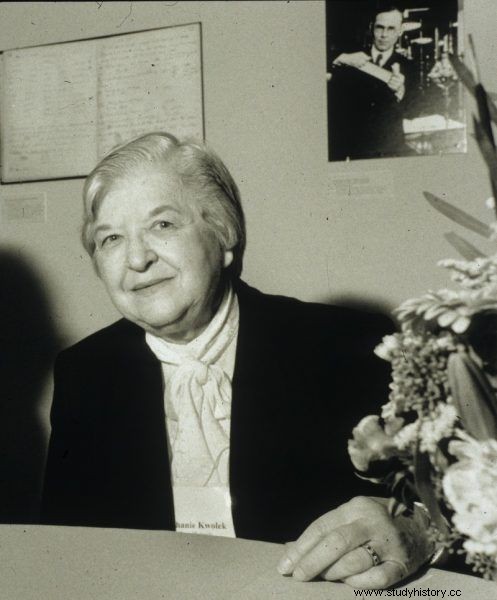When we talk about outstanding inventors, most of all, Maria Curie-Skłodowska comes to mind. And although her contribution to modern science is indisputable, the pages of history hide many other outstanding female minds. Here are five women whose inventions changed our everyday lives.
Hedy Lamarr - Hollywood mother of WiFi
The life story of a woman who is considered to be the precursor of the WiFi network could easily serve as a script for a Hollywood movie. Hedy Lamarr, or in fact Hedwig Eva Maria Kiesler, was born in Vienna in 1914 to a wealthy, assimilated Jewish family. From an early age, she dreamed of an acting career, which she made her dream come true, incl. thanks to its exceptional beauty. At the age of 19, her role in the controversial film "Ecstasy" brought fame. The film caused such a stir that Adolf Hitler banned it from being shown in Germany.

Hedy Lamarr
However, her career path took a different course. In 1933, she married one of the richest Austrians, Friz Mandla, who traded in weapons with the Third Reich. Lamarr from this marriage, apart from acquaintance with Mussolini and Hitler, learned about advanced weapons. The relationship itself, however, did not survive. Heda's growing aversion to the Nazis, and thus to Friz, contributed to her escape to London.
In the capital of Great Britain, she met Louis Mayer, who encouraged her to go to the USA and sign a contract with MGM. Her acting career, however, faded over time, leading Heda towards science. In 1941, together with her friend and composer, George Antheil, she patented a torpedo control system using radio waves. As time was to show, their invention was ahead of its time. The technology of spreading the spectrum of the signal with frequency hopping was not used during the Second World War, but it returned with the Cuban crisis. Since then, it has been gradually developed, and one of its varieties has become the widely available GSM network and IEEE 802.11, the WiFi standard on which is based.
Josephine Cochrane - for the sake of time and tableware
Dishwasher - a device without which most of us cannot imagine our lives, was patented in 1886 by Josephine Cochrane. This American hostess, apart from organizing delicious parties, was also a great lover of her tableware. Fearing its destruction by the servants, she was supposed to wash the plates by hand. However, due to the amount of time she wasted doing this, she decided to look for a better solution.
Thanks to her persistence and creativity, she created a device that revolutionized home kitchens. A mechanic, George Butters, helped her in this task. Together, they built the first hand-operated dishwasher and then set up a manufacturing company. Over the years, they created a version powered by a steam engine. Interestingly, the design of their models did not differ much from modern dishwashers.

Josephine Cochrane on a postage stamp
The success of Josephine Cochrane with her invention is all the more impressive when we realize that the late nineteenth century was a period when many homes did not yet have access to hot or running water.
Stephanie Kwolek - lightness and endurance
We owe the daughter of two Polish emigrants the invention of Kevlar. Stephanie Kwolek associated her professional career first with fashion design, and later with medicine. Unfortunately, the medical studies she wanted to go to after graduating in chemistry in Pittsburgh proved too expensive. To afford them, Kwolek joined DuPont as an experimental chemist. It was there that she discovered her true calling - synthetic materials.

Stephanie Kwolek
Stephanie has contributed to the development of various materials, including Lycra. However, Kevlar brought her the greatest fame. This polymer is associated primarily with bulletproof vests, but its use is much wider.
Thanks to its extraordinary durability, Kevlar is used in fiber optic cables, vehicles (from bicycles to aviation), in the production of tires, speaker membranes and all kinds of clothing and footwear. Wherever high strength and low material weight are needed.
Letitia Mumford Geer - a syringe for everyone
In 1899, the medical world was changed by another tool that is indispensable to this day - the medical syringe. While the injections were not new anymore, the patient could not give them without the help of another person. This was changed by Letitia Mumford Geer.
The Letitia syringe consisted of a barrel with a nozzle and a plunger for injecting or withdrawing fluids. And most importantly, it could be operated with one hand. This revolutionary feature changed the concept of treating patients and changed the lives of many patients. The invention of Geer allowed, among others diabetics to take insulin on their own.
To this day, syringes based on her patent are an inseparable element of medical equipment.
Florence Parpart - fresh produce in every home
Florence Parpart is behind the invention of another device that can be found in every home. Although we know little about her life, we owe her the creation of the first version of the electric refrigerator.

Florence Parpart
She patented her invention in 1914, and then together with her husband she started to produce a new device on a mass scale. An interesting fact is that initially electric refrigerators were not expected to be very successful. This one, however, has come, transforming the homes of people all over the world.
It's also worth mentioning that Florence didn't just invent the refrigerator. Fifteen years earlier, she had patented the first street-sweeping machine.
Bibliography:
- C. Montague, Women of Invention:Life-Changing Ideas by Remarkable Women, Chartwell Books, 2018
- C. Thimmesh, Girls Think of Everything:Stories of Ingenious Inventions by Women, HMH Books, 2002
- A.L. Macdonald, Feminine Ingenuity:How Women Investors Changed America, Ballantine Books, 1994
- S. Braun, Incredible Women Inventors, Second Story Press, 2007
- https://www.britannica.com/biography/Stephanie-Kwolek, 5/21/2020
- http://www.worldsweeper.com/History/FlorenceParpartSweeperInventor1901.html, 5/21/2020
